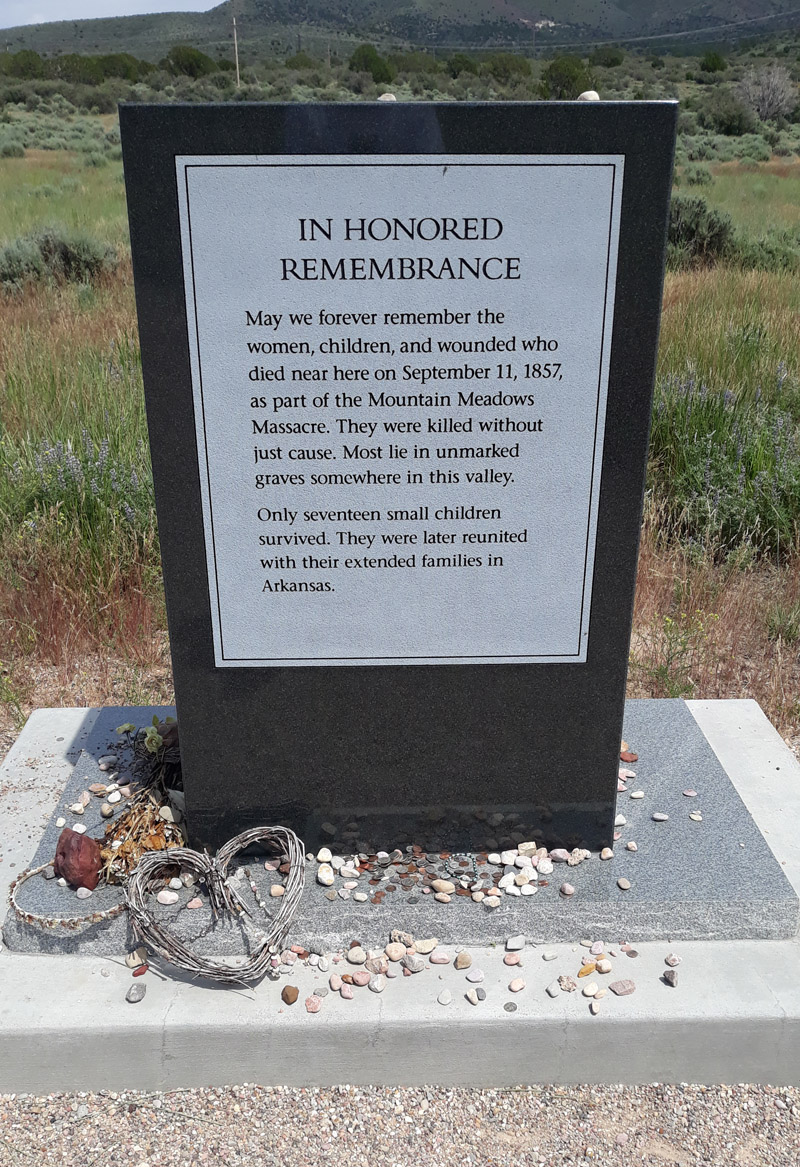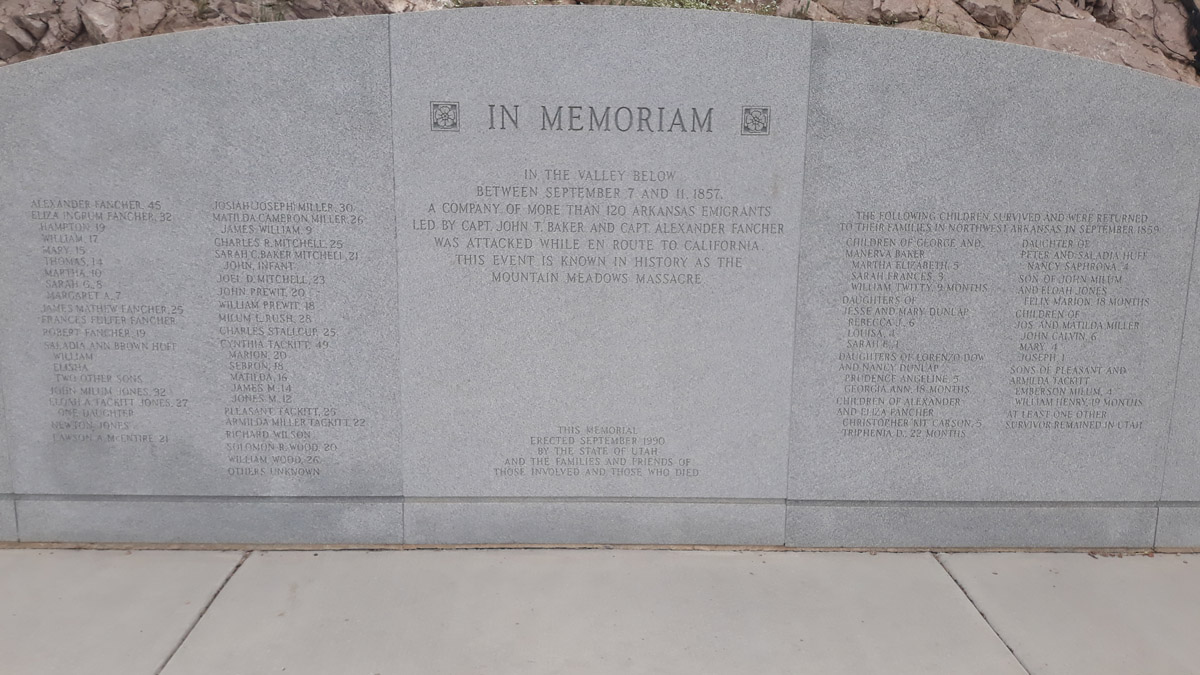
Mormon History
MOUNTAIN MEADOWS MORMON MASSACRE - SEPTEMBER 11, 1857

History of Indian Depredations in Utah (no mention of the Mormon Mountain Meadows Massacre) - 1919
Mountain Meadows Mormon Massacre Smoking Gun Sermon - 9/13/1857
Brigham Young and the Massacre at Mountain Meadows
The tragedy at Mountain Meadows, September 1857
Brigham Young Preaching Murder in the 1850s
Philip Klingon Smith Confession
More Information on the Mormon Mountain Meadows Massacre
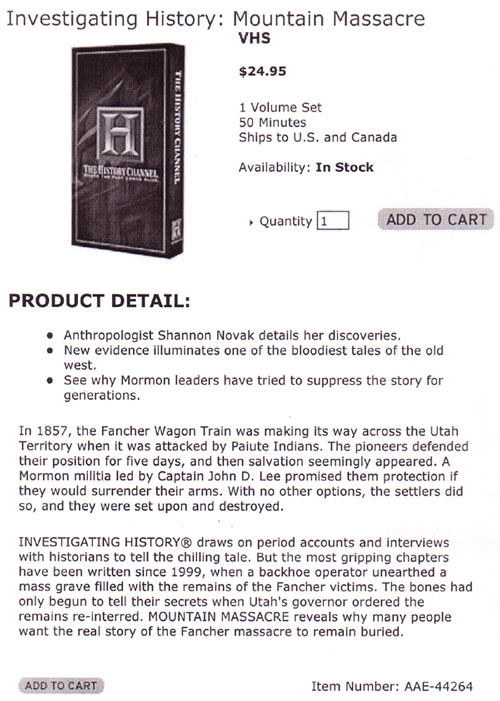
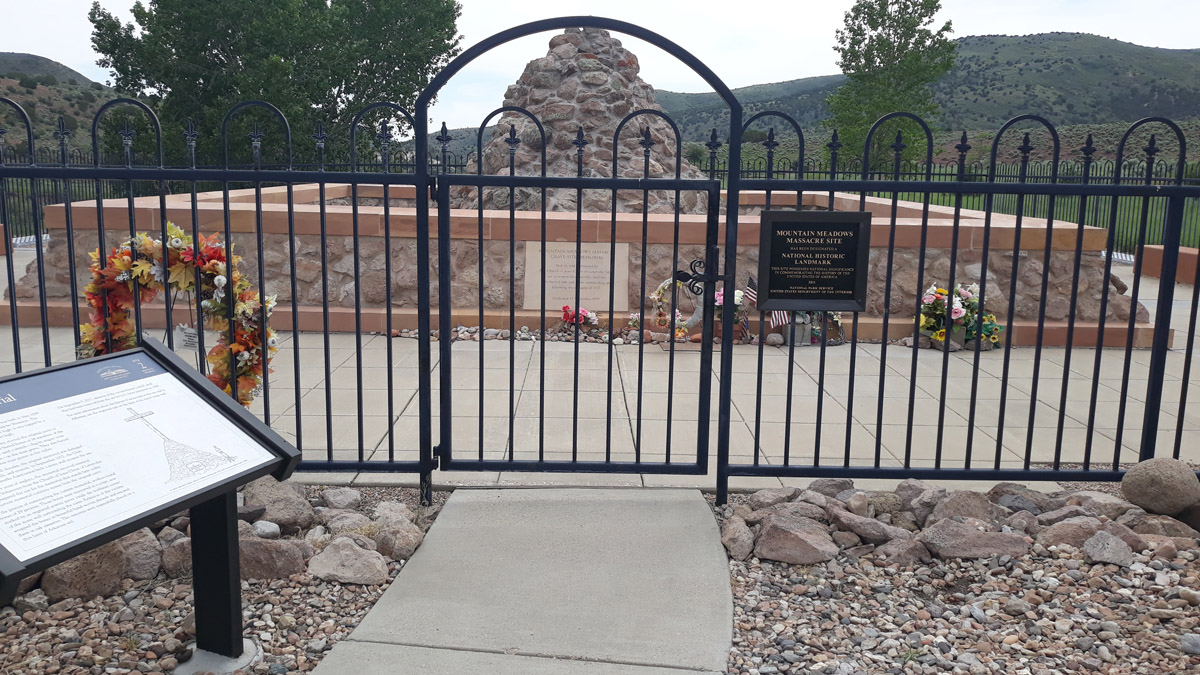
St. Louis Christian Advocate – November 26, 1857
THE MORMON TROUBLES are increasing. It is now pretty
generally believed, that the recent terrible massacre of over one
hundred California emigrants was instigated by them. Should this be
proven true, there is scarce any punishment they do not deserve. The
recital of the depredations committed by the Indians at the instigation
of the Mormons, if indeed it were not done by Mormons in the disguise of
Indians, is horrible. There is much trouble ahead in reference to these
infatuated and very bad people.
THE MASSACRE OF THE EMIGRANTS ON THE PLAINS -- THE MORMONS
SUPPOSED TO BE AT THE BOTTOM OF IT. -- The Los Angeles Star
gives the following additional details
with reference to the horrible massacre of an emigrant train on the
Plains by the Indians, of which we recently gave the substance:
"The scene of the massacre is differently designated, as the Santa Clara
canyon, the Mountain Springs, and the Mountain Meadows. But all agree in
locating it near the rim of the Great Basin, about fifty miles from
Cedar City, the most southern of the Mormon settlements, and three
hundred miles from Salt Lake City. Of a party of about 130 persons, only
fifteen infant children were saved. The account was given by the Indians
themselves to the Mormons at Cedar City, to which place they brought the
children, who were purchased from them by the people of that city.
"Whether the cause assigned is sufficient to account for the result, or
whether a different cause is at the bottom of the transaction, we will
leave the reader to form his own conclusion. We can scarcely believe
that a party traveling along a highway would act in the manner
described, that is, to poison the carcass of an ox, and also the water,
thus endangering the lives of those who were coming after them. Yet this
is the story told by all who have spoken of the massacre. It is stated,
the emigrants had an ox which died, and they placed poison in the body,
and also poisoned the water standing in pools, for the purpose of
killing the Indians; that several of the tribe had died from this cause,
and that the whole force mustered and pursued the train, and, coming up
with them at the above named place, which favored their purpose,
attacked and murdered the whole party, except a few infant children.
"The Indians state that they made but one charge on the party, in which
they cut off the greater portion of the men, and then guarded the
outlets of the canyon, and shot the men and women down as they came out
for water; that one man was making his escape with a few children, and
they followed him, killed him, and took the children, fifteen in number,
the eldest under five years of age."
The Star prefaces the letter of J. W. Christian, with the
following remarks:
"The writer seems to indicate that the Mormons will be held responsible
for the murder, and in this respect he is fully borne out by present
implications, for a general belief pervades the public mind here that
the Indians were instigated to this crime by the 'Destroying Angels' of
the Church, and that the blow fell on these emigrants from Arkansas, in
retribution of the death of Parley Pratt, which took place in that
State. The truth of the matter will not be known until the Government
makes an investigation of the affair. This should be done to place the
blame in the right quarter, as well as to inflict chastisement on the
immediate actors in the fearful tragedy, who are reported to be the
Santa Clara tribe of Indians."
Telegraphic News of the Week.
...
Nov. 19. -- New York. -- Col. Alexander's letter to Adjutant General
Cooper says: "I cannot, for fear of being intercepted, tell you the
strength of my command. It is strong enough to defend itself and its
supplies, but whether it is able to assume and sustain an offensive
position remains to be seen; but should the commands which I have heard
are in the rear come up in time, I think we will have a sufficient force
to carry out an active invasion. If we are obliged to winter in the
mountains, you can perceive, by reference to Stansbury's maps, that we
have an open road to Salt Lake City in the spring, which, I am told, is
open early. By this an attack xan be made and attention called from the
main road, that by Fort Bridger, which may be traversed by the troops.
the Bear river route is, however, said to be in the best order in the
valley. the other passes through canyons, which can be defended by a
handful of men against thousands, and is moreover so easily obstructed
that in a week it could be made utterly impassable.
"The want of cavalry is severely felt, and we are powerless on account
of this deficiency, yo effect any chastisement of the marauding Indians,
that are continually hovering around us."
The Herald says that Gen. Harney, with a large force, will be dispatched
for Utah as soon as he can effect an entrance into the Territory.
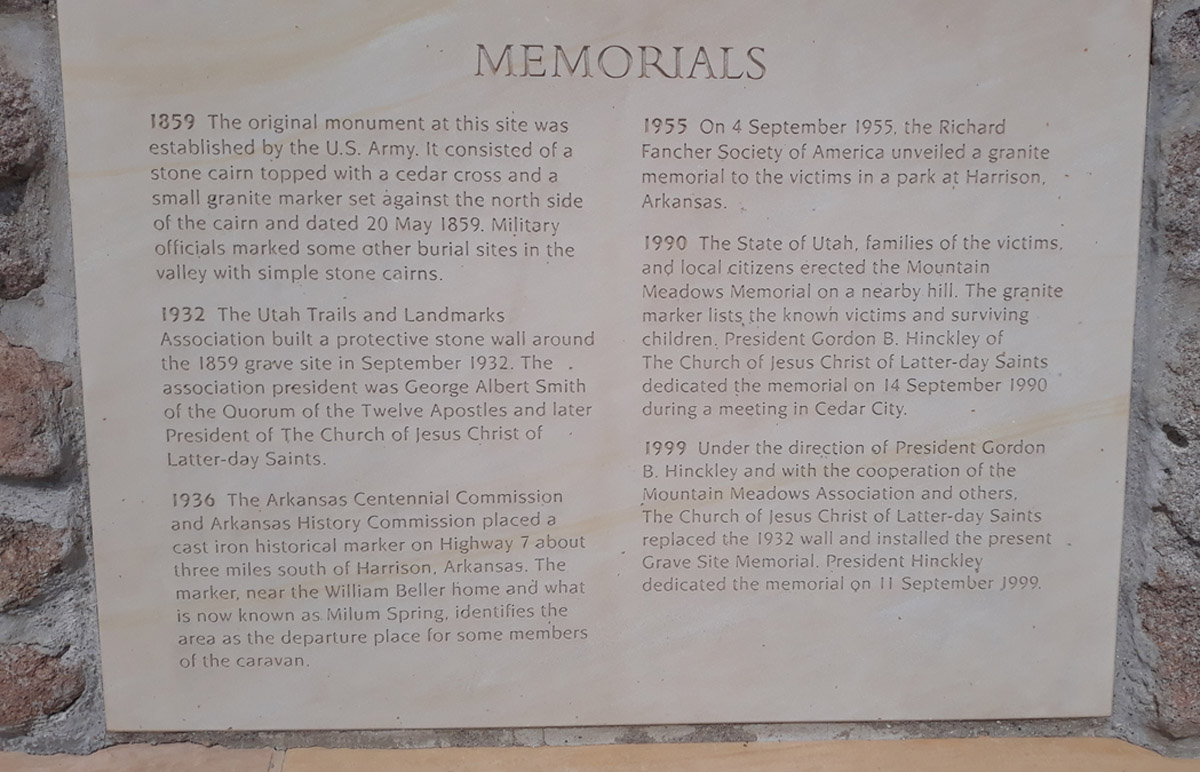
Mormon church, foundation at odds over Mountain Meadows monument
The Associated Press
06/25/2007
Descendants
of a 120-member Arkansas immigrant party say their plea for federal
stewardship of the Mountain Meadows mass grave site has been rejected
by LDS Church.
Phil Bolinger and Scott Fancher of the
Arkansas-based Mountain Meadows Monument Foundation say they got the
news June 6 in a telephone call from Elder Marlin Jensen, who oversees
the church history department.
"He told us that President (Gordon B.) Hinckley had
turned us down. He doesn't think it's in the best interests of the
church to allow federal stewardship in the meadows," said Bolinger,
the foundation president who is related to 30 of those killed. "That
really bit me bad."
Jensen declined an interview, but confirmed through
spokeswoman Kim Farah that the church will not pursue federal
stewardship of the site. A similar request was also rejected in 1999.
Descendants want the site in the hands of a neutral
third party because they believe the institutional church is complicit
in the murders.
"It's not right for the people who had complicity
to the killings to be the grave owner," said Bolinger, who discussed
the issue with Jensen on April 25 in Salt Lake City.
"I asked him, 'How you do you think the Kennedy
family would feel if the Lee Harvey Oswald family had control of the
Kennedy tomb?'"
History hangs the Sept. 11, 1857, event on southern
Utah Mormon leaders and a small band of Paiute Indians, leaving the
culpability of then-church president Brigham Young up for debate. An
upcoming book from church historians takes the same position.
Headed to California, the wagon train led by Capt.
Alexander Fancher and John Baker arrived in the Utah territory at the
same time the federal government was mounting pressure on the Mormon
church for its practice of polygamy and disregard for federal
oversight.
They camped first near Salt Lake City and then
headed south to the meadow, a well-known stopover on the old Spanish
Trail. The immigrants were attacked and spent a week engaged in gun
skirmishes before local Mormon Elder John D. Lee rode in on horseback
with a white flag to negotiate their rescue.
Persuaded to walk single-file and unarmed from the
valley, the immigrants were shot at close range, stabbed or beaten to
death. Their bodies were not buried.
Seventeen children were spared, all of them under
age six _ young enough, some said, not to remember or speak of what
they saw. The youngsters were adopted by local families and later
returned to their relatives in Arkansas.
Lee was tried, convicted and executed for the
massacre 20 years later and is the only person ever held responsible.
Today, the Mountain Meadows monument site is a
2,500-acre parcel in a rolling scrub-pine and sagebrush valley about
35 miles northwest of St. George.
The land is a patchwork of public and private
holdings, some of which was passed down through families from pioneer
ancestors.
There are four known mass grave sites and two
memorials _ the rock pyramid known as the Carelton Cairn on the valley
floor and a memorial wall on Dan Sill Hill, which overlooks the valley
and is inscribed with the known names of victims from the 29 different
families on the wagon train.
The monument is already on the National Park
Service's Register of Historic Places, but the designation doesn't
guarantee public access or public input before construction or other
site changes, foundation attorney Scott Fancher said.
Foundation members believe a higher designation,
such as national monument status, would better protect the interests
of all and salve the wounds of many Fancher party descendants, said
Bolinger, of Hindsville, Ark.
"Federal stewardship of this grave site ... that's
all it would take to put this to bed," he said.
Federal oversight might also have prevented the
Aug. 3, 1999, maintenance work on the cairn when a church crew
accidentally unearthed the remains of at least 28 men, women and
children. A forensic evaluation was begun, but cut short on an order
from Utah's then-Gov. Mike Leavitt, a descendant of some who
participated in the massacre.
At a dedication ceremony of the rebuilt cairn that
September, Hinckley said the church carries a moral responsibility to
remember the victims, but fell short of acknowledging church
complicity to the crime.
Mormon church leaders are committed to
appropriately preserving the Mountain Meadows site, Farah said.
"The church has owned the monument site at Mountain
Meadows for many years. The property is open to the public and
considerable time and resources are allocated to ensure that the
property is well-maintained, open to the public and that those who
perished there are appropriately remembered," she said.
Farah also confirmed what Washington County
recorder's office records show - over the past few months, the church
has increased its holdings in the meadow. Since March at least two
families have deeded their property over to the church.
"The church intends to administer and maintain this
property in like manner, thereby preserving it from either residential
or commercial development," said Farah.
Bolinger said the foundation, one of three
descendant groups, shared concerns that residential development in
fast-growing Washington County would damage the site. But he's rankled
by the church's acquisition of more land and says he'll continue to
push for federal stewardship.
"It's the highest honor we could pay these people," Bolinger said.
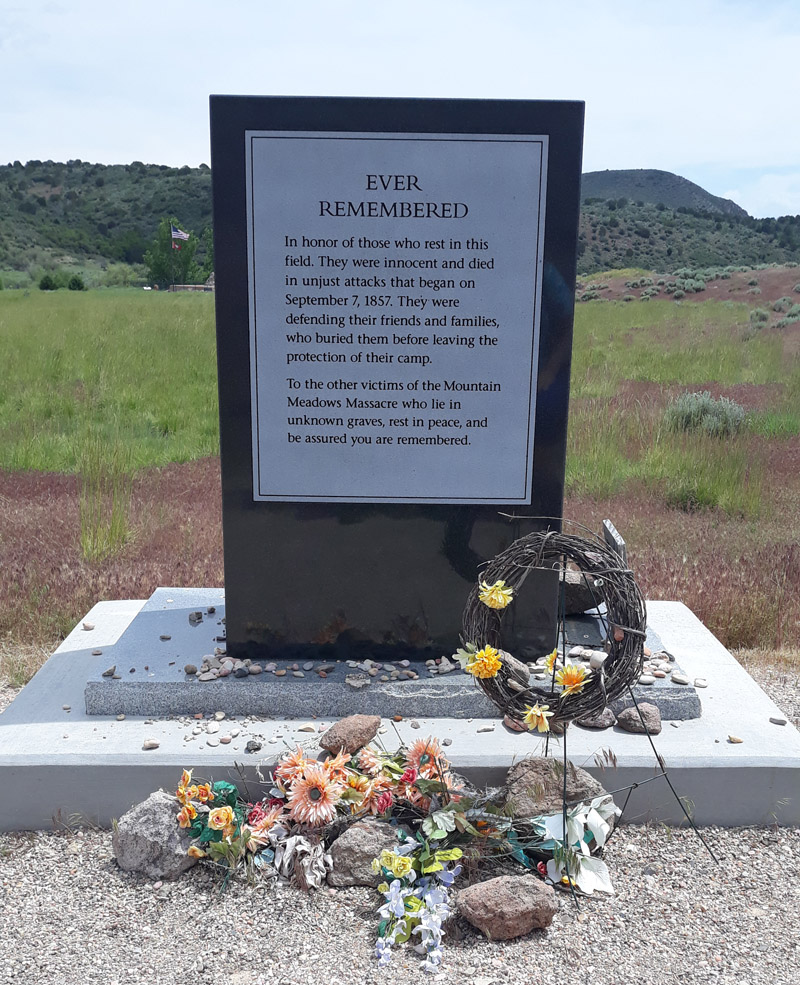
Wednesday, August 8, 2007
By Deborah Gertz Husar
Herald-Whig Staff Writer
Taping an episode of WTJR's "Truth Outreach" with host Rocky Hulse, the four men forgot about the cameras.
They didn't forget their story.
A massacre in 1857 in southwest Utah claimed the lives of some of their ancestors. What came to be called the Mountain Meadows Massacre shadows each generation, but Scott Fancher said the public knows little of "one of the single most important historical incidents" in the nation's history.
"Apart from the Oklahoma City bombing, this was the single largest act of domestic white-on-white violence in the history of the U.S.," he said.
The 150th anniversary of the massacre on Sept. 11 renews the push by Scott Fancher, Bob Fancher, Phil Bolinger, Ron Wright and the Mountain Meadows Massacre Foundation to boost awareness and gain federal stewardship of the property where the events occurred.
The effort pits the foundation against the Church of Jesus Christ of Latter-day Saints, which controls the burial sites and, the men say, has never taken responsibility for the deaths of 120 men, women and children.
Scott Fancher said perpetrators included church leaders and militia members. "They have never once apologized to the families of the massacred victims," he said. "We think frankly it's high damn time."
Alexander Fancher thought it was time to start a new life as a rancher in California in 1857. He gathered up 140 people — mostly relatives who were Methodists, not LDS members — and left Arkansas with 40 wagons, close to 1,000 cattle and 200 horses.
The Fanchon-Baker train was one of the wealthiest and best-provisioned wagon trains to make the trip through Kansas, then onto Salt Lake City and southwest Utah.
"What they didn't know probably was at the time Utah Territory was in rebellion against the U.S.," Bob Fanchon said.
"This wagon train happened to be at the wrong place at the wrong time," Bolinger said.
The train was besieged by Indians and local Mormons dressed as Indians. Fighting lasted until Sept. 11, when John D. Lee, representing the Mormons and the adopted son of Mormon leader Brigham Young, rode into the wagon camp under a white flag. Lee said the Indians would allow train member to leave, unarmed and without their possessions, under a Mormon escort.
The wagon train members — women holding their infants, children under the age of eight in one group, older children in another group and the men with individual Mormon escorts — walked along a one-mile stretch away from the wagons. Then a signal was given, and all but the youngest were massacred.
"The men mostly were lucky enough to be shot at point-blank range. The women and children, most of them received a billy club to the head," Bolinger said.
The attackers not only took the wagons and all the goods, but stripped the bodies of clothing and jewelry, Bob Fanchon said, and the bodies were left on the ground. The surviving children were taken in by Mormon families.
"It was such a horrible mess. They rerouted the wagon train (route) several miles so they wouldn't be able to smell the stink of the rot," Bolinger said.
U.S. Army Maj. James Carleton led the investigation of the incident. Carleton buried the dead in four mass graves, including one that came to be known as the Carleton Cairn marked with a cross, along the mile-long killing field. He testified before Congress and the Army returned the surviving children to their families in Arkansas in 1859.
Fifty-four warrants were issued, but Lee was the only one arrested.
"To this day, he was the only one out of the 50-plus clubbers and shooters that were on the killing field that day ever tried, convicted, executed and held responsible," Bolinger said.
"For the longest time, the Indians were blamed wrongly, the emigrants themselves were blamed," Scott Fanchon said. "More recently, the LDS church to its credit has admitted at least local Mormons were involved which we've all known."
The original cairn was destroyed and rebuilt several times. The most recent monument was built in 1999 by the church.
"It has a little plaque embedded in it the basically says the site is owned and maintained by the Church of Jesus Christ of Latter-day Saints. That's all the interpretation we get for the victims, for our families," Bolinger said.
Bolinger said the foundation won some initial support from Elder Marlin Jensen, the church's liaison with massacre descendant organizations, but lost that after church leadership declared it was "not in the best interest of the church" to pursue federal stewardship.
As a compromise, the foundation has asked the church to consider national historic landmark designation as a way to protect and preserve the site.
"The LDS church as an institution promotes many of its historic sites to be designated including Nauvoo and Temple Square," Scott Fanchon said. "When they say we don't want the federal government involved, we say it's a bit hypocritical."
Church spokespeople in Salt Lake City did not return a call from The Herald-Whig.
In a June story by the Associated Press, spokeswoman Kim Farah said Mormon leaders are committed to appropriately preserving the site.
"The church has owned the monument site at Mountain Meadows for many years. The property is open to the public, and considerable time and resources are allocated to ensure that the property is well-maintained, open to the public, and that those who perished there are appropriately remembered," she said.
In the same article, Bolinger said it's not right for the church to own the site. "How do you think the Kennedy family would feel if the Lee Harvey Oswald family had control of the Kennedy tomb?"
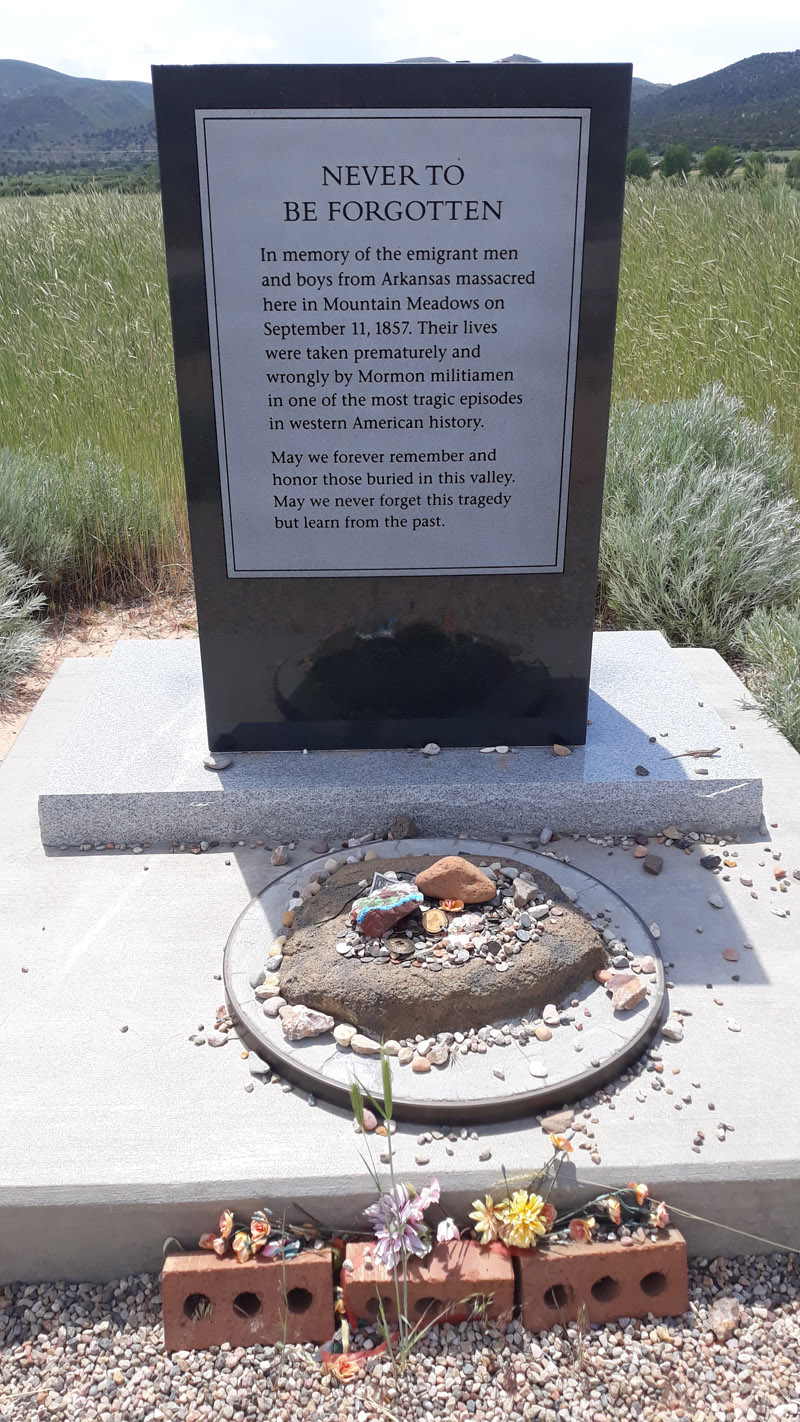
Innocent Blood
Essential Narratives of the Mountain Meadows Massacre
Edited by David L. Bigler, Will Bagley
Kingdom in the West: The Mormons and the American Frontier Series Volume
12
Original sources documenting a frontier atrocity and its cover-up.
The slaughter of a wagon train of some 120 people in southern Utah on
September 11, 1857, has long been the subject of controversy and
debate. Innocent Blood gathers key primary sources describing the
tangled story of the Mountain Meadows massacre. This wide array of
contrasting perspectives, many never before published, provide a
powerful and intimate picture of this "dastardly outrage" and its
cover-up.
The documents David L. Bigler and Will Bagley have collected offer a
clearer understanding of the victims, the perpetrators, and the reasons
a frontier American theocracy sought to justify or conceal the
participants' guilt. These narratives make clear that, despite limited
Southern Paiute involvement, white men planned the killing and their
church's highest leaders encouraged Mormon settlers to undertake the
deed.
This compelling documentary record presents the primary evidence that
tells the story from its contradictory perspectives. The sources let
readers evaluate and track the evolution of such myths as the Paiutes'
guilt, the emigrants' provocation of their murderers, Brigham Young's
ignorance of what happened, and John D. Lee's sole culpability. Clearly
revealed is the part Utah authorities took in blocking the
investigation until it became expedient to sacrifice Lee.
Together, these narratives show how the massacre's story has been
continually distorted and then revealed over 150 years—and how the
obfuscation and cover-up continue. Innocent Blood conveys the
encompassing impact the atrocity had on people's lives, then and for
generations after. It is a valuable sourcebook sure to prove
indispensable to future research.
About the Authors
David L. Bigler, former director of the Utah Board of State History, is
an independent historian whose award-winning books on Utah, California,
and western American history include Forgotten Kingdom: The Mormon
Theocracy in the American West, 1847–1896. Will Bagley, an independent
historian of the West, is author of Blood of the Prophets: Brigham
Young and the Mountain Meadows Massacre and editor of Pioneer Camp of
the Saints: The Mormon Trail Journal of Thomas Bullock, 1846–1847.
